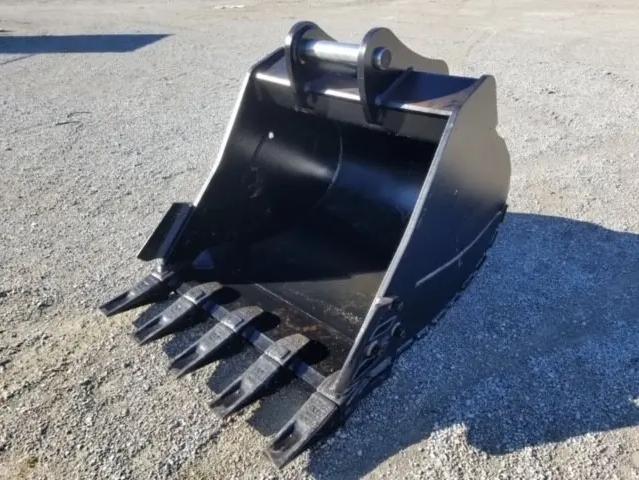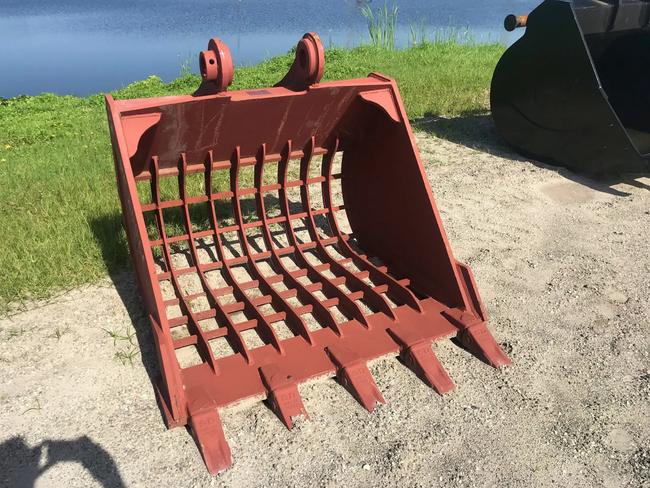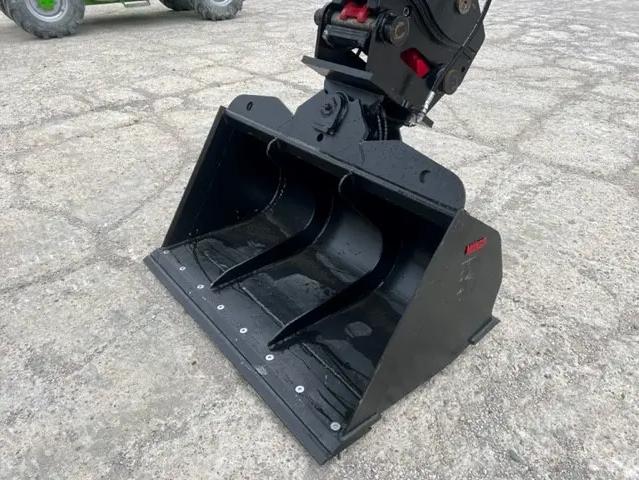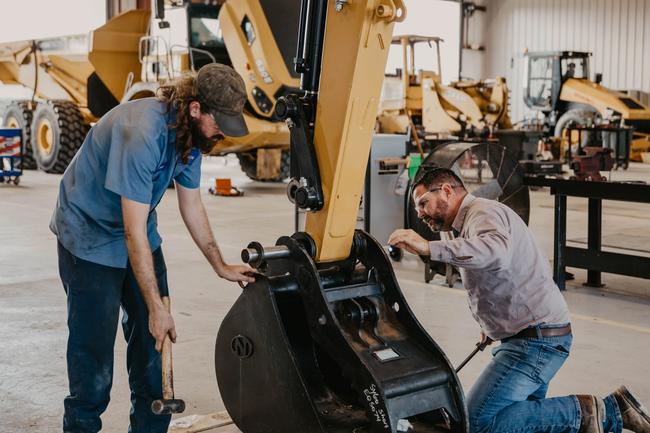Types of Excavator Buckets and Choosing the Right Ones
- News

Your bucket can make a difference in getting the job done right. Whether it's for digging trenches, moving earth, or precision work, the bucket you hook up to your excavator matters big time.
Whether you're behind the controls every day, managing a fleet of these beasts, or just have a thing for heavy machinery, we will break down the different kinds of excavator buckets and why nailing that coupler choice is your first step to a job well done.
Choosing the Right Coupler: The First Step
Before you even think about buckets, there's something essential you've got to lock down: the coupler. It's the part between your excavator and whatever bucket you choose. And some excavators aren’t equipped to handle a hydraulic coupler. Get this right, and you're off to a great start.
What’s a Coupler, Anyway?
A coupler, in simple terms, is the part that connects the excavator arm to the bucket for easier swapping between different attachments. It’s not technically necessary if you aren’t going to be swapping out your attachments.
Think of a coupler as a quick-change artist. It allows you to switch from one bucket type (or other attachment) to another, adapting your excavator for various tasks without a hassle.
Choosing Between Mechanical and Hydraulic Couplers
The coupler is a crucial component of your excavator setup, linking the arm to the bucket. Here’s a quick look at the two types: mechanical and hydraulic couplers.
Mechanical Couplers
Mechanical couplers, sometimes called manual couplers, are simple and cost-effective. Ideal for operations where bucket changes are infrequent. They require manual pin removal and insertion, which is straightforward but time-consuming. It might take multiple people to remove and add attachments on larger machines.
Hydraulic Couplers
Hydraulic couplers, also known as quick couplers, allow for rapid bucket changes, often directly from the excavator cab. Your operator won’t have to stop what they’re doing to get in and out of the excavator. They offer time-saving benefits for jobs needing multiple attachments.
Choosing the right coupler for your operation prepares you for everything you do next with your excavator, ensuring you’re ready for whatever task.
Different Types of Excavator Buckets
Alright, now that you’ve got the coupler situation sorted, it’s time to talk buckets. Excavator buckets are more than just big metal scoops. Depending on their design and build, they can do many different jobs.
Digging Buckets

Digging buckets are probably the most common buckets you’ll see. These fan favorites have teeth that can cut through various materials, making them an important part of any excavation project.
Key Features of Digging Buckets
- Tailored for digging tasks, these buckets come with strong teeth ideal for breaking into and scooping up materials like soil and clay.
- Digging buckets are available in multiple sizes and shapes, offering flexibility to suit different project scales and material types.
Why Digging Buckets Are a Popular Choice
- From trench creation to landscape grading, digging buckets are the go-to option for general excavation tasks.
- Their design maximizes their efficiency in excavation, making them a popular and effective tool in the construction field.
Ditch-Cleaning Bucket

When it’s time to tidy up and fine-tune, the ditch-cleaning bucket enters the spotlight. This bucket isn’t about the rough-and-tumble; it’s about precision and neatness, especially when you're working on creating or maintaining ditches and slopes.
Design and Purpose
- Ditch cleaning buckets are designed with a wide and smooth edge, making them perfect for shaping, grading, and cleaning rather than heavy digging.
- Their shallow depth and smooth profile allow for easy handling of light materials, making them ideal for creating gentle slopes and removing sediment or debris from ditches.
Effective in Specific Scenarios
- Picture yourself working on landscaping, road maintenance, or creating drainage channels. Here’s where a ditch-cleaning bucket truly excels. Its design allows for precise contouring and finishing work, essential in these scenarios.
- They’re also great for clearing waterways or ditches, ensuring efficient water flow and preventing blockages. Because of their wide and flat design, they can cover a larger area in one smooth motion, making clean-up and finishing work a breeze.
Skeleton Bucket

It’s more than just a cool name. With its unique design and specific uses, the skeleton bucket is a must-have for certain projects where sorting and sifting are needed.
Unique Design and Uses
- The skeleton bucket stands out with its grid-like construction. Think of it as a bucket with spaces or 'ribs' that allow smaller materials to fall through while retaining larger items.
- It’s ideal for sorting and sifting debris from soil, rocks, or other materials. This bucket is a star in tasks like site cleanup, landscaping, or when you need to separate materials for recycling.
Benefits
- One of the biggest perks of using a skeleton bucket is efficiency. It saves time and effort by allowing you to sift through and sort materials directly on-site.
- The skeleton bucket can be a game-changer for projects involving excavation in areas with a lot of debris or where material grading is necessary. It allows for more precise separation without additional equipment or manual sorting.
- Its design also provides better visibility for the operator, making it easier to manage the sorting process and reducing the risk of accidentally discarding valuable material.
Rock Bucket

When it’s time to face the hard-hitting jobs, the rock bucket steps up to the plate. This robust and rugged bucket can handle some of the toughest tasks in excavation, where strength and endurance are non-negotiable.
Construction and Uses
- Rock buckets are built tough, with reinforced steel and aggressive teeth that can bite into and scoop up rocky materials. They're the heavy hitters when you’re dealing with hard, compact materials or a large amount of debris.
- Ideal use cases for rock buckets include quarry work, mining operations, and construction sites where digging through hard ground or removing large boulders and heavy rock debris is the order of the day.
- Rock buckets can also be used instead of regular buckets in areas with super rocky soil.
Durability and Design Features
- What sets rock buckets apart is their enhanced durability. They often feature additional wear plates, reinforced side cutters, and robust teeth that can withstand the abrasive nature of rock handling.
- The design maximizes penetration and breakout force. Rock buckets can dig into and scoop up hard materials more effectively than standard buckets.
- They also typically have a more aggressive profile and increased capacity to handle larger volumes of rocky material, ensuring efficient excavation and material handling in rock-heavy environments.
Tilt Bucket

Tilt buckets add a new dimension of flexibility to excavator work. With their ability to tilt side-to-side, they bring an enhanced level of precision to tasks that standard buckets might struggle with.
Design and Functionality
- In some models, tilt buckets have a tilting mechanism, allowing them to tilt left and right up to 45 degrees. This feature provides exceptional versatility, especially in shaping and grading work.
- They typically have a straight edge, making them perfect for creating smooth, even surfaces and for precision landscaping and site preparation work.
- They save time, too, by preventing you from having to reposition your machine.
Ideal Uses
- These buckets shine in projects requiring delicate shaping, like forming slopes, grading land, or cleaning ditches. Their ability to tilt makes them excellent for tasks that require a more nuanced approach than a standard bucket can offer.
- They are also useful in projects where space is limited or fine adjustment is needed, allowing operators to maneuver and contour in ways that traditional buckets can’t.
- We've seen them in forestry, moving trees with a thumb or grapple. They’re becoming super popular on the scene.
Matching Bucket Types to Project Needs
Selecting the right bucket for your excavator goes beyond just finding a fit. It's about choosing a bucket that aligns with the specific demands of your project, thus ensuring efficiency, reducing wear, and positively impacting project timelines. Here's a guide to help you select the ideal bucket for your needs.
Understanding Project Requirements
- Begin by identifying the primary job. A standard digging bucket with teeth is typically sufficient for general digging tasks in soft soil if you're working in rocky terrain or need to perform demolition.
- The type of material you’re working with is also a key consideration. A digging bucket can handle the job well for lighter materials like soil and gravel. Opt for a rock bucket designed for tougher conditions for denser materials, like heavy rocks or concrete.
Soil Conditions and Bucket Selection
- The soil type will influence your choice of bucket. Loose, sandy soils are easier to handle with a standard digging bucket, while dense, clay-heavy soils might require a bucket designed for tougher digging conditions.
- When working with tougher soils or materials, choose a bucket built for durability. Look for buckets with reinforced construction and stronger teeth to withstand abrasive environments.
Scaling to Your Project
- The size and scope of your project should dictate the bucket size. Larger projects may need buckets with greater capacity, while smaller or more detailed tasks might benefit from smaller, more precise buckets.
- Select a bucket that matches your excavator's capabilities and the project’s requirements. An oversized bucket for a small excavator can hamper efficiency, just as a small bucket on a large project can slow down progress.
Maintenance and Care for Excavator Buckets

Taking good care of your excavator buckets isn't just about keeping them looking nice; it's about extending their life and ensuring they perform at their best. Regular maintenance and proper care can save you from costly repairs or replacements down the line. Sometimes, replacing a smaller bucket is less expensive than repairing it. But cracks should always be addressed ASAP. Plus, well-maintained buckets mean more efficient and safer operations.
Why Bucket Maintenance Matters
- Regular upkeep of your buckets is a classic case of preventive maintenance. By keeping an eye on wear and tear and addressing issues early, you prevent bigger problems and potential equipment failures in the future.
- A well-maintained bucket ensures that your excavator works efficiently. It also reduces the risk of accidents due to equipment failure, keeping your job site safer.
Maintenance Tips for Excavator Buckets:
- Regular Inspections: Make it a habit to inspect your buckets regularly. Look for signs of wear, cracks, or damage, especially in high-stress areas like teeth and cutting edges.
- Timely Repairs: If you spot any damage, don’t put off repairs. Small cracks can quickly turn into big problems. Welding and reinforcing areas with a lot of wear can extend your bucket’s life.
- Replace Worn Parts: Monitor the bucket teeth and cutting edges. These parts wear out over time and should be replaced to maintain efficiency and digging capability.
- Cleaning: Don’t underestimate the power of cleaning your buckets. Removing dirt and debris after use can prevent rust and corrosion, especially when working in harsh or damp conditions.
- Lubrication: If your bucket has any moving parts, like in a tilting or grading bucket, regular lubrication is essential to keep them moving smoothly.
Get Started With Buckets
The right coupler and bucket combination will help you reach your excavator's full potential and beef up your attachment arsenal. Whether digging, grading, or trenching, the correct setup ensures optimal performance and efficiency. Always weigh your project needs carefully, and don't hesitate to seek expert advice to make the best choice for your specific requirements. In the end, a well-matched coupler and bucket can make all the difference in the success of your excavation tasks.
